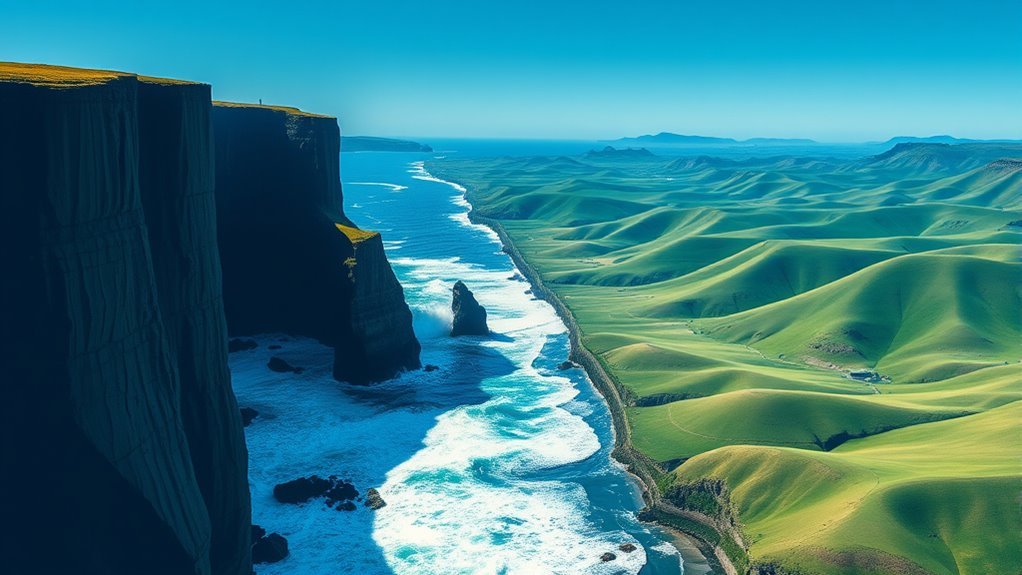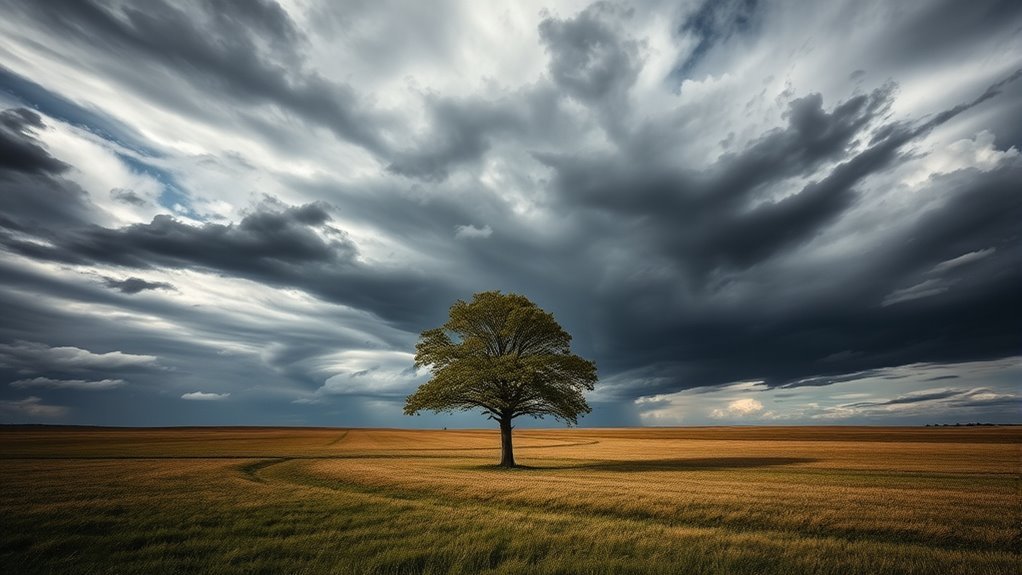Coastal and inland regions experience squalls in distinct ways due to differences in geography and atmospheric conditions. Coastal areas often see intense squalls, driven by warm ocean air and funneling topography, resulting in severe thunderstorms and high wind speeds. In contrast, inland squalls tend to be more localized, featuring rapid interactions between warm and cool air masses. Both areas require specific preparedness strategies to effectively manage these sudden weather events. More understandings into these phenomena await exploration.
Main Points
- Coastal squalls are often more intense due to warm ocean air rising, leading to severe thunderstorms.
- Inland squalls are usually more localized, resulting from interactions between warm, moist air and cooler air masses.
- Coastal regions experience amplified wind speeds from topography, while inland areas have varying topographical influences on squall development.
- Precipitation from coastal squalls can lead to storm surges, while inland squalls may cause flash flooding from intense downpours.
- Coastal communities must remain vigilant for rapid weather changes, while inland areas may have less predictable squall occurrences.
Understanding Squalls: Definition and Characteristics
Squalls are sudden, sharp increases in wind speed, often accompanied by rain or thunderstorms. These meteorological events typically occur over short durations, ranging from minutes to a few hours, and can lead to considerable disruptions.
Squalls can manifest as a result of various atmospheric conditions, especially the collision of air masses with differing temperatures and moisture levels.
The distinguishing feature of a squall is its intensity; wind speeds can escalate rapidly, sometimes exceeding 30 knots. Such abrupt changes can create hazardous conditions, particularly for maritime activities and aviation.
Additionally, the accompanying precipitation can range from light rain to heavy downpours, increasing the risk of flash flooding. The unpredictable nature of squalls makes them a critical concern for weather forecasting.
Understanding these characteristics is essential for preparing for their impact, particularly in regions prone to such weather phenomena.
The Role of Geography in Squall Formation

Geographical features play an important role in the formation of squalls, as they influence local atmospheric conditions. Mountains, valleys, and bodies of water can greatly alter wind patterns and humidity levels, contributing to the development of squalls.
For instance, mountainous regions can create orographic lift, where moist air is forced upward, cooling and condensing to form storm clouds. In contrast, flat terrains may allow for the rapid heating of air, leading to convection currents that can trigger squall formation.
Additionally, proximity to large bodies of water can impact temperature fluctuations, with coastal areas often experiencing more humidity and consequently greater potential for intense rainfall during squalls. Inland regions may have drier conditions, which can limit the intensity of squalls.
Coastal Regions: Amplified Effects of Squalls
Coastal regions are particularly susceptible to the heightened effects of squalls due to their unique atmospheric conditions. The proximity to large bodies of water creates a dynamic interplay between warm, moist air and cooler air masses, intensifying the development of squalls.
As warm air rises rapidly over the ocean, it can lead to the formation of severe thunderstorms that produce heavy rainfall, strong winds, and even hail. These squalls often move quickly, resulting in sudden and intense weather changes that can catch communities off guard.
Additionally, coastal topography, including cliffs and bays, can funnel and increase wind speeds, further exacerbating squall impacts. The interaction of squalls with coastal features often leads to localized phenomena, such as waterspouts or storm surges, which pose considerable risks to maritime activities and coastal infrastructure.
As a result, residents and local authorities must remain vigilant and prepared for the rapid onset of these severe weather events.
Inland Areas: Localized Squall Events

How do localized squall events manifest in inland areas? Unlike coastal regions, where squalls may develop over larger expanses, inland squalls are typically more confined in nature. They often result from the interaction of warm, moist air with cooler, denser air masses, leading to rapid changes in weather conditions.
These events can occur suddenly, defined by intense downpours, strong gusts of wind, and sometimes hail. Inland areas may experience squalls as part of larger storm systems, but the localized nature means that one area may face severe weather while nearby regions remain relatively calm.
The topography, such as hills and valleys, can further influence how these squalls develop and dissipate, creating unique weather phenomena. Consequently, residents in inland regions must remain vigilant and prepared for sudden weather shifts that can occur with little warning.
Wind Patterns and Their Impact on Squalls
While various atmospheric conditions contribute to the formation of squalls, wind patterns play an essential role in their intensity and movement. In coastal regions, prevailing winds often lead to the rapid development of squalls as moist air converges with cooler air masses, creating instability. These winds can enhance squall strength, resulting in intense precipitation and gusty conditions.
Conversely, in inland areas, wind patterns frequently differ, with localized breezes influenced by terrain and land use. This may lead to less predictable squall behavior, resulting in sporadic and often weaker squall events.
The interaction between different air masses can also create boundaries, where squalls can form or dissipate more readily. Understanding these wind dynamics is critical for predicting squall occurrence and severity, as they greatly influence how these weather phenomena manifest in diverse environments.
The Influence of Topography on Weather Systems
Topography greatly influences weather systems by altering air flow patterns and creating localized climatic conditions. Mountain ranges, valleys, and plateaus can greatly affect how air masses move, leading to variations in precipitation and temperature.
For instance, when moist air encounters a mountain, it is forced upward, cooling and condensing into clouds, which often results in heavy rainfall on the windward side. Conversely, the leeward side, known as the rain shadow, may experience arid conditions due to descending dry air.
Additionally, coastal areas benefit from the moderating influence of large bodies of water, while inland regions may experience more extreme temperature fluctuations. These topographical features can intensify squalls, with coastal areas experiencing sudden storms fueled by warm ocean air, while inland regions may face dry, gusty winds that precede severe weather.
Understanding these dynamics is vital for predicting and preparing for weather events across different terrains.
Preparing for Squalls: Strategies for Coastal and Inland Communities
Understanding the unique challenges posed by squalls is vital for both coastal and inland communities. Effective preparation can greatly mitigate the impact of these sudden weather events. Coastal regions often face high winds and flooding, while inland areas might experience severe thunderstorms and rapid temperature changes.
Both communities can adopt several strategies to improve their readiness:
- Develop emergency plans tailored to specific squall risks.
- Educate residents about squall signs and safety protocols.
- Invest in weather monitoring systems to provide timely alerts.
- Collaborate with local authorities for coordinated response efforts.
- Create community support networks to assist vulnerable populations during squalls.
Common Questions
How Do Squalls Affect Marine Life in Coastal Areas?
Squalls considerably impact marine life in coastal areas, often causing sudden changes in water temperature and salinity. This can disrupt feeding patterns, affect reproduction, and lead to the displacement of various marine species.
Are Squalls More Frequent During Specific Seasons?
Research indicates that squalls tend to be more frequent during changing seasons, particularly spring and fall. Changes in temperature and atmospheric pressure during these times create conducive conditions for the development of squall lines.
Can Squalls Cause Tornadoes or Other Severe Weather?
Squalls can indeed lead to severe weather phenomena, including tornadoes. The rapid changes in wind and atmospheric pressure associated with squalls may create conditions conducive to tornado formation, particularly in unstable weather systems.
What Historical Events Were Caused by Squalls?
Historical events attributed to squalls include devastating maritime disasters, such as shipwrecks, and severe thunderstorms causing property damage. Notable examples involve the 1969 hurricane squalls affecting coastal towns, leading to substantial flooding and destruction.
How Can Technology Improve Squall Forecasting?
Advancements in technology improve squall forecasting through improved satellite imagery, data analytics, and real-time monitoring systems. These developments enable meteorologists to predict squalls with greater accuracy, allowing for timely alerts and better preparation for affected regions.

